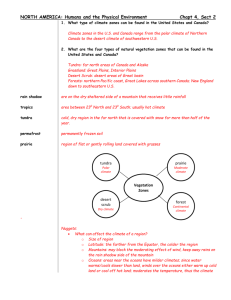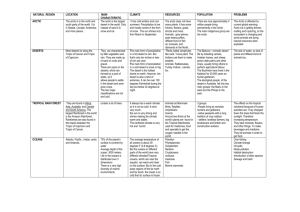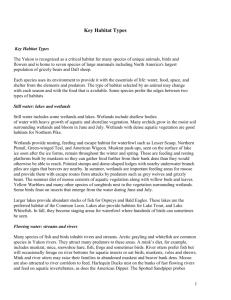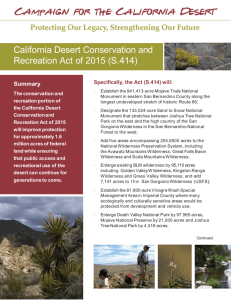Types of outdoor environments
advertisement
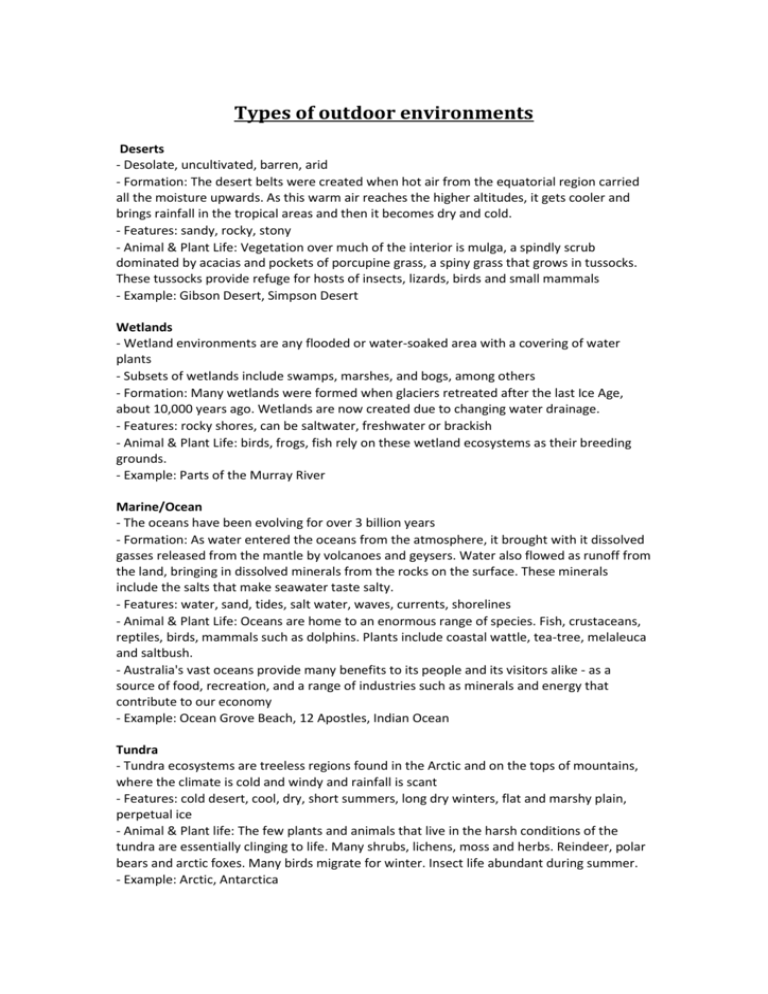
Types of outdoor environments Deserts - Desolate, uncultivated, barren, arid - Formation: The desert belts were created when hot air from the equatorial region carried all the moisture upwards. As this warm air reaches the higher altitudes, it gets cooler and brings rainfall in the tropical areas and then it becomes dry and cold. - Features: sandy, rocky, stony - Animal & Plant Life: Vegetation over much of the interior is mulga, a spindly scrub dominated by acacias and pockets of porcupine grass, a spiny grass that grows in tussocks. These tussocks provide refuge for hosts of insects, lizards, birds and small mammals - Example: Gibson Desert, Simpson Desert Wetlands - Wetland environments are any flooded or water-soaked area with a covering of water plants - Subsets of wetlands include swamps, marshes, and bogs, among others - Formation: Many wetlands were formed when glaciers retreated after the last Ice Age, about 10,000 years ago. Wetlands are now created due to changing water drainage. - Features: rocky shores, can be saltwater, freshwater or brackish - Animal & Plant Life: birds, frogs, fish rely on these wetland ecosystems as their breeding grounds. - Example: Parts of the Murray River Marine/Ocean - The oceans have been evolving for over 3 billion years - Formation: As water entered the oceans from the atmosphere, it brought with it dissolved gasses released from the mantle by volcanoes and geysers. Water also flowed as runoff from the land, bringing in dissolved minerals from the rocks on the surface. These minerals include the salts that make seawater taste salty. - Features: water, sand, tides, salt water, waves, currents, shorelines - Animal & Plant Life: Oceans are home to an enormous range of species. Fish, crustaceans, reptiles, birds, mammals such as dolphins. Plants include coastal wattle, tea-tree, melaleuca and saltbush. - Australia's vast oceans provide many benefits to its people and its visitors alike - as a source of food, recreation, and a range of industries such as minerals and energy that contribute to our economy - Example: Ocean Grove Beach, 12 Apostles, Indian Ocean Tundra - Tundra ecosystems are treeless regions found in the Arctic and on the tops of mountains, where the climate is cold and windy and rainfall is scant - Features: cold desert, cool, dry, short summers, long dry winters, flat and marshy plain, perpetual ice - Animal & Plant life: The few plants and animals that live in the harsh conditions of the tundra are essentially clinging to life. Many shrubs, lichens, moss and herbs. Reindeer, polar bears and arctic foxes. Many birds migrate for winter. Insect life abundant during summer. - Example: Arctic, Antarctica Mountain - Mountains usually have steep, sloping sides and sharp or slightly rounded ridges and peaks. - Formation: Mountains are formed when two pieces of the Earth's crust smash into each other the land can be pushed upwards, forming mountains - Features: The summit, or the top of a mountain The slope, or side of the mountain A very steep valley between young mountains, known as a gorge - Animal & Plant Life: Many mountain ranges are home to rare plants and animals. These environments are especially fragile as a result of human interference. Kangaroos, Wallabys, - Example: Mt Bogong Forest - Tropical – hot/wet - Also referred to as a wood or the woods, is an area with a high density of trees - Formation: A typical forest is composed of the over story (canopy or upper tree layer) and the understory. The understory is further subdivided into the shrub layer, herb layer, and also the moss layer and soil microbes. - Features: Tropical: lowland, tableland, and highland rainforests, trees grow fast. Cool: simpler structure, higher middle latitudes. - Animals & Plant Life: Tropical: tree ferns, lichens, ferns, herbaceous plants. Insects, frogs, birds, bats, snakes, ants. Cool: pine, beech, myrtle. Deer, foxes. - Examples: Wet forests & Rainforests: Otway Ranges, Wilson’s Promontory Dry forests & Woodlands: Ironbark Forest near Bendigo Wilderness (see www.wilderness.net/index.cfm?fuse=NWPS&sec=whatIsWilderness) - The most intact, undisturbed wild natural areas left on our planet - those last truly wild places that humans do not control and have not developed with roads, pipelines or other industrial infrastructure. - Formation: Wilderness areas are areas that have been inhabited and modified by Indigenous people although they did not see their environment as wilderness but as their home. - Features: untouched, indigenous artwork, - Animal & Plant Life: depends on where the wilderness environment is. - Examples: Avon Wilderness Urban/Built Environments - Human-made surroundings that provide the setting for human activity, ranging from personal shelters and buildings to neighbourhoods and cities that can often include infrastructure e.g. water supply or energy networks - Formation: formed by human activity often costing a great deal of money to build - Features: man made, roads and car parks, buildings - Animal & Plant Life: most plant life is planted by people including types of trees and shrubs. Animals generally birds, pets including dogs, cats etc, not always of a local nature - Examples: buildings, schools, shops, roads, pipelines.
